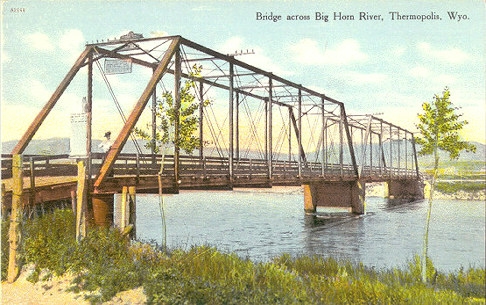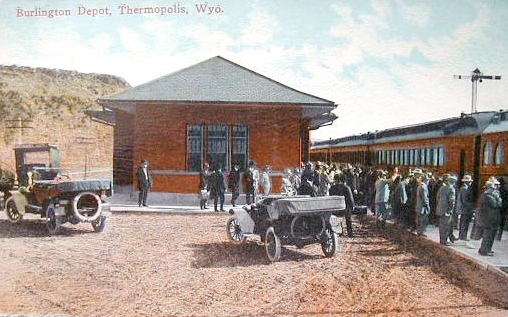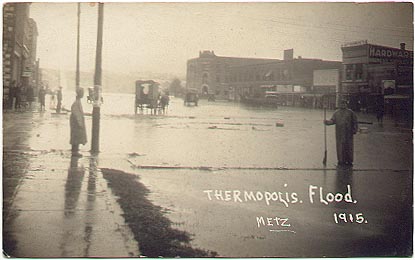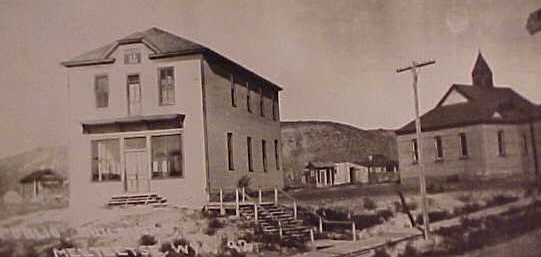
| Photos From Wyoming Tales and Trails This Page: Thermopolis, Meeteetse |
 |

| Photos From Wyoming Tales and Trails This Page: Thermopolis, Meeteetse |
 |
 Thermopolis, 1918 Click here for closeup Compare the above photo with current* Thermopolis below. Although the present city was not founded until 1897, the area across the Big Horn River at Owl Creek was settled in 1870 by the Anderson Brothers. The Anderson's original intent was to establish a bean farm, but they ended up founding a town, variously known as Andersonville, Anderson's Hog Ranch, or, after the founding of Thermopolis on the other side of the river, "Old Thermopolis."
 Big Horn River Bridge, Thermopolis, undated  Burlington Depot, Thermopolis, approximately 1918
Thermopolis is the site of the world's largest warm mineral springs which were made available to the general public without charge as a result of a treaty with the Shosone and the Araphao in 1896. By 1901, the town had a population of approximately 500 and there were at least three privately owned bathhouses, the Hotel Pleasant View Hotel and Bathhouse, the Hot Springs Hotel and Bath House, and the Star Plunge Bath House. Transportation was provided by stage lines providing service to Basin, Meeteetse, Lander and Casper. Even today use of the State Bathhouse is without charge, although there is a nominal charge for towels and other items. The Plaza Hotel, pictured above right, now a Quality Inn, was built in 1918 and has recently received renovations restoring its glory.  Early view, business section Thermopolis, photo by Metz  of the 1915 flood also taken by Metz.
of the 1915 flood also taken by Metz.Legend Rock, approximately 20 miles from Thermopolis, has petroglyphs dating back approximately 2,000 years including images associated with the Hopi and Incan cultures. Access is available through inquiry at the State Park. In 1947, the State Legislature adopted the Cottonwood as the state tree. At the time the world's largest cottonwood was located on the Paul Klein ranch, formerly the J. M. Cover homestead, three miles north of the city. At the time the tree was estimated to have a height of fifty feet and a circumference of 29 feet 4.5 ft. above the ground. Other sources indicate that the tree had attained a height of 76 ft. 11 in. In 1955 the tree burned. In 1990 a search conducted under the auspices of the Wyoming Chapter of the Society of American Foresters determined the largest cottonwood to be on the Flying X Ranch in eastern Albany County, measuring 31 ft. in circumference, 64 ft. tall, and an average crown spread in excess of 100 ft.  Meeteetse Schools, 1910
Ranching in the Upper Greybull Valley started with the founding of the Pitchfork
Ranch west of present day Meeteetse by Otto Franc in 1879.
1937 Belden photo of winter conditions on Pitchfork Ranch left. Another photo by Belden below right. The Pitchfork has in recent years been used as a shooting site for Marlboro cigarette ads. The ranch is also a habitat for the black-footed ferret.
Meeteetse, "meeting place" in Shoshone, became a terminus of the old Meeteetse Trail
built by the army in 1881, as a stage * Current Photo of Thermopolis from Thermopolis Chamber of Commerce, Martina Pohl, Photographer |